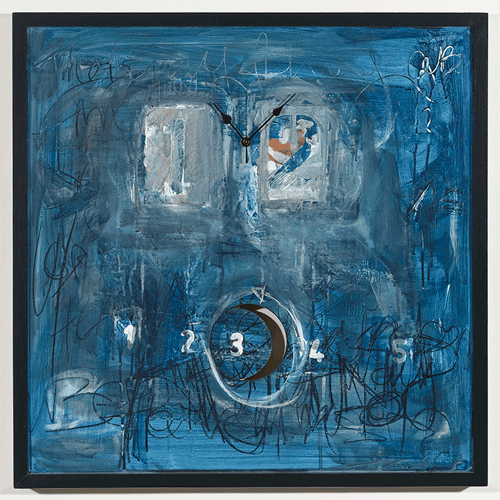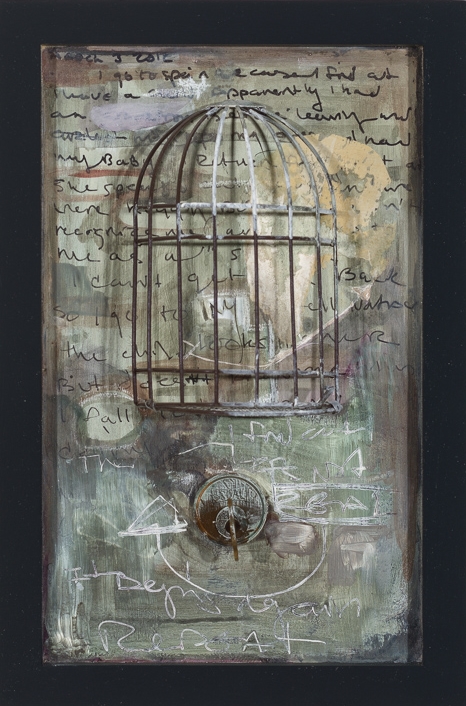Marina Korenfeld, "Abraxas"
(Copyright in all images in this post held by Marina Korenfeld).
Today Lobster & Canary features rising star Marina Korenfeld. We own a copy of "Abraxas," which is the last picture we see every day as we leave our apartment, hanging as it does right by the door.
"City of Creaking Statues"
Lobster & Canary Question One: Marina, your work reminds me of Paul Klee’s early etchings (for instance, "Two Men Meet, Each Believing The Other To Be Of Higher Rank”) and his illustrations for Candide. And also his iconic "Golden Fish". You mention elsewhere that Klee is indeed an inspiration—tell us more about that. What in particular inspires you from Klee’s work?
Korenfeld: "I once read how Paul Klee marveled and envied children’s ability to create a polymorphous art free of conformed concept of what is called 'beautiful, recognizable and understandable'. He also found inspirational their use of colors, unhesitant line work and the ability to invent symbols and signs. I’m pretty sure he studied children’s drawings and paintings to pick up on those skills. Looking at his art I see precisely these interests of his, but not in the form of dry scientific research; rather, its a game – mysterious, promising, dynamic and always fun. The Spirit of Childhood never left Klee, it allowed him to turn into a unique (but likable) artist full of inner light.
So the reason my work might remind you of some of Paul Klee’s art is because in the line of my work (art teacher) I am subjected to viewing, discussing and helping to create a lot of awesome masterpieces by 5 – 12 year old artists. Very attentively I listen to their judgments, associations, and trends – for no one can feel and experience the fabric of reality with the subtlety of those who haven’t yet turned 21. For an artist hardly creates anything herself; like a child hunting dragonflies, she snatches forms and ideas drifting in the ether…Paul Klee reminds me to never lose an inner child to continue being an artist."
So the reason my work might remind you of some of Paul Klee’s art is because in the line of my work (art teacher) I am subjected to viewing, discussing and helping to create a lot of awesome masterpieces by 5 – 12 year old artists. Very attentively I listen to their judgments, associations, and trends – for no one can feel and experience the fabric of reality with the subtlety of those who haven’t yet turned 21. For an artist hardly creates anything herself; like a child hunting dragonflies, she snatches forms and ideas drifting in the ether…Paul Klee reminds me to never lose an inner child to continue being an artist."
"Bahamut"
Question Two: I also see hints of Klimt, Schiele, Chagall in your figures. Any comments to that observation?
Question Two: I also see hints of Klimt, Schiele, Chagall in your figures. Any comments to that observation?
Korenfeld: "In his 'Blue Beard,' Kurt Vonnegut writes about an artist who creates a perfect world on his canvas, walks into it and eventually disappears in its reality. In my etchings I create portals into the reality of my own ideal world and I ask myself if I’d be willing to step into the world I create and be seduced into staying there.
I see the works by Klimt, Schiele and Chagall as these wonderful windows I’d love to walk into. And after contemplating the amazing beauty and passion and unlimited fantasy of these worlds I’d dress my figures in gold and stunning ornaments or undress and brand them with the intricate tattoos that could mean something to Yaqui Indians or J.L. Borges (who else teaches us to encrypt and decipher better than him?).
After absorbing Schiele with all the fibers of my soul, I’d play 'If You Were In My Movie' and make my figures stand, dance, fly, fall in the most expressive way, in the way that spoken language is pointless and weak and body language is most vivid, eloquent and truthful in the slightest details.
And Chagall’s tenderness and nostalgia helps my characters to manifest their hidden desires and dreams; it defies gravity and turns other laws of Nature into a joke or a hoax."
I see the works by Klimt, Schiele and Chagall as these wonderful windows I’d love to walk into. And after contemplating the amazing beauty and passion and unlimited fantasy of these worlds I’d dress my figures in gold and stunning ornaments or undress and brand them with the intricate tattoos that could mean something to Yaqui Indians or J.L. Borges (who else teaches us to encrypt and decipher better than him?).
After absorbing Schiele with all the fibers of my soul, I’d play 'If You Were In My Movie' and make my figures stand, dance, fly, fall in the most expressive way, in the way that spoken language is pointless and weak and body language is most vivid, eloquent and truthful in the slightest details.
And Chagall’s tenderness and nostalgia helps my characters to manifest their hidden desires and dreams; it defies gravity and turns other laws of Nature into a joke or a hoax."
"Fish and Ram"
Question Three: You majored in puppetry at Odessa’s Theater & Art College. I sense your early training in the way you pose and articulate the figures in your work—they are graceful, seemingly poised in deliberation, delicate, elegantly moving through the space of the composition, limber. Do you draw on puppetry in your visual art?
Question Three: You majored in puppetry at Odessa’s Theater & Art College. I sense your early training in the way you pose and articulate the figures in your work—they are graceful, seemingly poised in deliberation, delicate, elegantly moving through the space of the composition, limber. Do you draw on puppetry in your visual art?
Korenfeld: "I get a lot of comments about my theatrical background showing throughout my pieces. Not only did my college education center on theater and drama, but my family life did too: my father was an accordion teacher and my mom was a drama professor. Our house was visited by their students, artists, musicians, actors, comedians, and poets. Often I did my school homework sitting somewhere in the orchestra pit during the numerous rehearsals my mom was directing. And so the theatrical atmosphere was just naturally absorbed by my developing sense of reality. Hence the stage-like compositions of my etchings. Theater proved to me how magical and persuasive its ways are. Being at Theater Art College had taught me another valuable trade – stylizing, artifice, a stepping away from reality in order to avoid falsehood [highlighting by Lobster & Canary; we love this phrase] and to achieve a deeper physiological effect. I still remember when our teacher wreaked all havoc when one of the students used real human hair for her marionette. And as a result instead of a beautiful wild fairy it turned out a human mannequin, creepy and dead.
Question Four: You are self-consciously aiming to find the heart of our mythologies, to construe the symbolism of our deepest dreams. You evoke the mystic and limn the enigmatic. Talk please about the quest you undertake as you create, and the quest you presumably hope your viewers will take along with you.
Korenfeld: "There is a very specific perspective I want my viewers and myself to have, of the wondrous labyrinth of the soul, the marvelous invisible cities the spirit lives in, the fantastic imaginary creatures who fill our inner world. My eternal question is 'Who am I?' The complexity and the mystical powers of the human psyche never cease to amaze/amuse me. One of the examples of such mystical powers is our belief mechanism, which defines who we are: if we love ourselves, then people love us. What occurs to us in our life actually depends on us – I don’t mean the plans we make and the goals we accomplish. Rather, I’m talking about serendipity, wondrous coincidences, unexpected changes in the trajectory of life. I think that we attract certain events into the orbit of our life and thus construct our own reality. Someone who believes in aliens, God, the devil, love or in a conspiracy theory will find all kinds of evidence and supporting material for her belief; someone who believes that he is generally unlucky will always find evidence of that as well. And what about the mantra 'Think positive?' Who doubts the power of that? Seriously, I lament that we’re spending such gigantic sums of money on exploring space. The most remote — mysterious — incomprehensible cosmos is the inner world of each and every one of us and the unexplored mystical powers that reside within each and every one of us."
Question Five: You mention as literary influences authors such as Borges, Marquez, Eco and Hesse. (You remind me also of Blake, Rilke, Montale, Angela Carter). How does the written word affect your creative process, your painting?
Korenfeld: "Reading books has always been an alternative to drugs for me (to the bitter disappointment of some of my fans and fellow artists, I don’t do drugs and to my utter amazement was booed and looked down upon for breaking the stereotype a couple of times). Apart from entertainment and education books change my perception of the world. A good book is always a trigger, it creates the particularity of the moment. And I love and cherish those moments which lead to a new dimension of reality: when life is no longer routine because you start to pay attention and notice something interesting or particular about your surroundings. Once you alter your mindset and break out of habitual patterns of perception, you notice a child in an amusing hat, a woman impossibly tall, a bearded man clutching an unusual case. But the most valuable of these 'profane illuminations' occur when I notice how often the details of my own life coincide with the private stories of the literary characters in the book I’m currently reading. These coincidences really amuse me: if I read a description of a room and it mentions a clock, most likely this clock will show the hour of my present moment.
There are priceless nuances and key words in the books mentioned in the question – 'encyclopedia', 'imaginary being', 'Abraxas', 'changed reality', 'archetype', 'solitude', 'journey'… These words evoke a certain chain of particular associations that lead you to explore a pathway in an imaginary world."
There are priceless nuances and key words in the books mentioned in the question – 'encyclopedia', 'imaginary being', 'Abraxas', 'changed reality', 'archetype', 'solitude', 'journey'… These words evoke a certain chain of particular associations that lead you to explore a pathway in an imaginary world."
Question Six: Which comes first for you: the form and the line, or the field and the color?
Korenfeld: "Since my primarily used medium is etching, where the artist has to express her ideas through the use of light and shadows and the lines of the drawing, I say form and line are the decisive principals of the work. But I love adding a bit of color and especially love using some gold leaf to add zest and to contrast the minimalism of the color palette."
The lobster and the canary thank Marina Korenfeld for her insights into her work...and for the magical work itself. For more images and a bio on Korenfeld, click here.
The lobster and the canary thank Marina Korenfeld for her insights into her work...and for the magical work itself. For more images and a bio on Korenfeld, click here.








